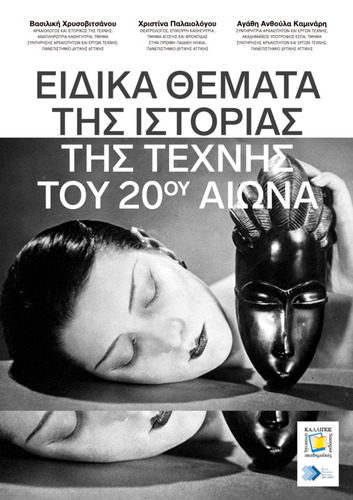| Title Details: | |
|
Special Topics in 20th Century Art History |
|
| Authors: |
Chrysovitsanou, Vasiliki Palaiologou, Christina Kaminari, Agathi Anthoula |
| Subject: | HUMANITIES AND ARTS > HISTORY > ARCHAEOLOGY HUMANITIES AND ARTS > HISTORY > ARCHAEOLOGY > ARCHAEOLOGY OF BRONZE AGE IN THE AEGEAN HUMANITIES AND ARTS > ARTS AND LETTERS > ARTS > ART STYLES > AVANT-GARDE ART HUMANITIES AND ARTS > ARTS AND LETTERS > ARTS > ART STYLES > MODERN ART HUMANITIES AND ARTS > ARTS AND LETTERS > ARTS > ART THEORY > AESTHETICS HUMANITIES AND ARTS > ARTS AND LETTERS > ARTS > ART THEORY > ART HISTORY HUMANITIES AND ARTS > ARTS AND LETTERS > ARTS > ART THEORY > ARTISTIC CREATION HUMANITIES AND ARTS > ARTS AND LETTERS > ARTS > ARTISTIC MOVEMENTS |
| Keywords: |
Twentieth-century art
Modernism Expressionism Cubism Italian futurism Dada Metaphysical art Surrealism Pop Art New realism Photorealism Appropriation art Graffiti / Street Art Greek Shadow Theatre |
| Description: | |
| Abstract: |
This academic textbook entitled "Special Topics in 20th Century Art History", is addressed to students whose curriculum includes the course History of 20th Century Art. The textbook contains 12 chapters, which refer to artistic movements of the 20th century. Each art movement is described through a characteristic theme that engages with the artists and captures the movement’s heyday. The chapters of the text are as follows: 1. The ""primitive"" in German Expressionist painting 2. Modern sculpture and Primitivism 3. Back to reason: A new interpretation of the world. Cubism 4. The machine, symbol of the Italian Futurists 5. Ancient myths in the work of the de Chirico brothers (Giorgio de Chirico and Alberto Savinio) 6. Dreams and Nightmares in Surrealism 7. The irrational element in art. Paraphrases of a theme: The case of Ubu Roi 8. The ""animation"" of the object as a resonance of Pop Art 9. Appropriation Art: creation or stasis? 10. Photorealism: a misunderstood movement 11. Street Art: the art of the ephemeral 12. Forms οf the Shadow Theatre in 20th century Greek painting. Each chapter is completed with passages from theoretical texts (manifestos of artistic groups, texts by artists, etc.), which contribute to a better understanding comprehension of important issues of 20th century art history. Information is also provided on the impact of the movements in the fields of literature and theatre. The texts are offered for further study and invite students to reflect on key issues in art history. Each chapter begins with a summary of the material and concludes with recapitulation exercises, followed by a comprehensive bibliography. This textbook provides the opportunity for students to use it as a resource or to select individual topics and delve deeper into them.
|
| Linguistic Editors: |
Ntafos, Vaios |
| Graphic Editors: |
Dimolas, Konstantinos |
| Type: |
Undergraduate textbook |
| Creation Date: | 25-05-2023 |
| Item Details: | |
| ISBN |
978-618-228-006-5 |
| License: |
Attribution - NonCommercial - ShareAlike 4.0 International (CC BY-NC-SA 4.0) |
| DOI | http://dx.doi.org/10.57713/kallipos-235 |
| Handle | http://hdl.handle.net/11419/9538 |
| Bibliographic Reference: | Chrysovitsanou, V., Palaiologou, C., & Kaminari, A. (2023). Special Topics in 20th Century Art History [Undergraduate textbook]. Kallipos, Open Academic Editions. https://dx.doi.org/10.57713/kallipos-235 |
| Language: |
Greek |
| Consists of: |
1. The "primitive" in German Expressionist painting 2. Modern sculpture and Primitivism 3. Back to reason: A new interpretation of the world. Cubism 4. The machine, symbol of the Italian Futurists 5. Ancient myths in the work of the de Chirico brothers (Giorgio de Chirico and Alberto Savinio) 6. Dreams and Nightmares in Surrealism 7. The irrational element in art. Paraphrases of a theme: The case of Ubu Roi 8. The "animation" of the object as a resonance of Pop Art 9. Appropriation Art: creation or stasis? 10. Photorealism: a misunderstood movement 11. Graffiti / Street Art: The art of the ephemeral 12. Forms οf the Shadow Theatre in 20th century Greek painting |
| Number of pages |
434 |
| Publication Origin: |
Kallipos, Open Academic Editions |
| You can also view | |
| User comments | |
There are no published comments available! | |

